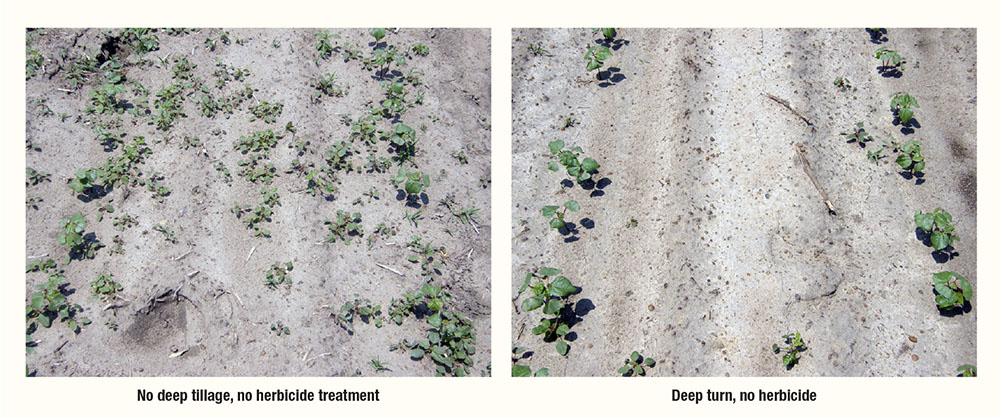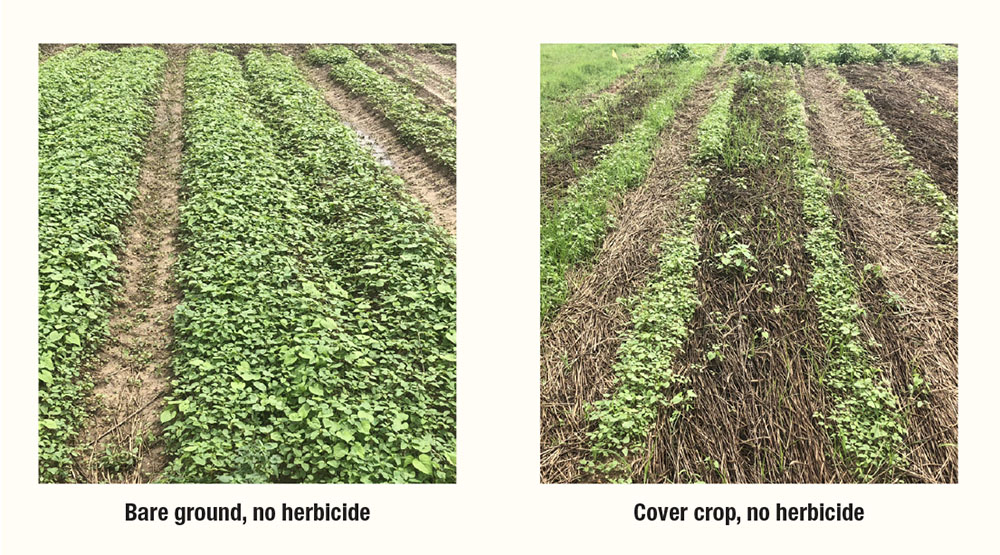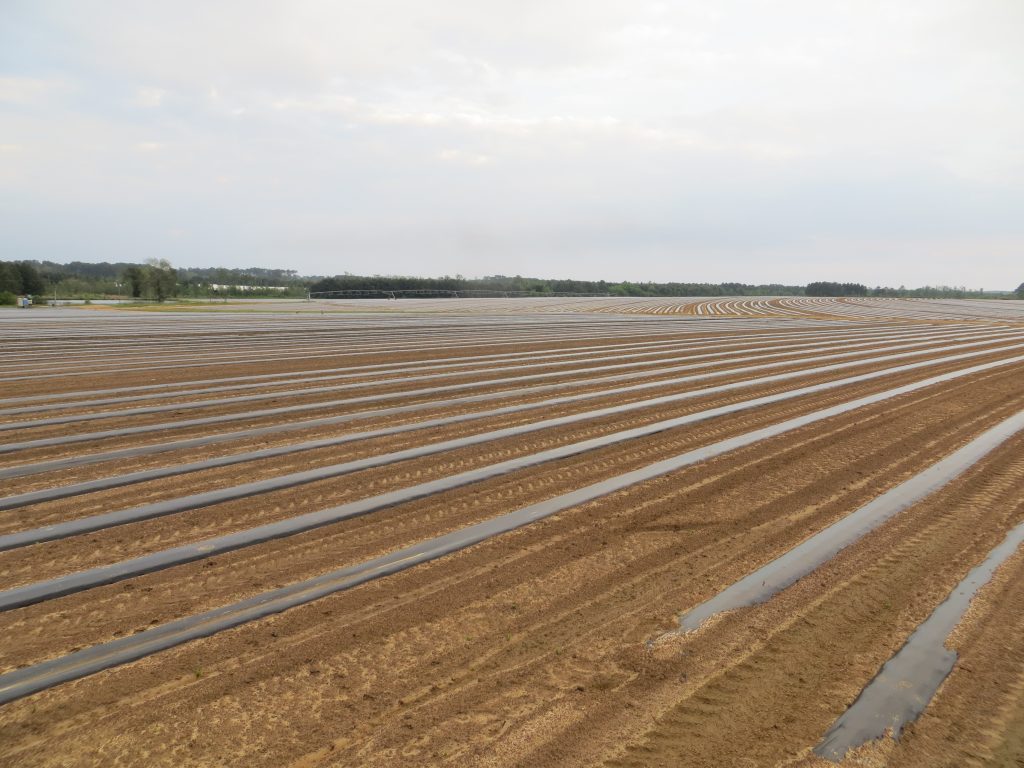
By A.S. Culpepper and J.C. Vance
Watermelon production is fascinating, diverse and complex as are the weed management programs currently available. The first step to success is ensuring no weeds are emerged when planting. Tillage, cover crops and/or herbicides offer effective options.

Tillage, commonly used, includes numerous options from preparing the land to plowing row middles. For weed control, deep turning the land can be extremely effective in reducing weed emergence (Figure 1). Understanding the longevity of weed seeds and how often to deep turn the ground is important.
Cover crops can also be effective by impeding weed emergence and preventing light penetration to the soil, thereby reducing emergence (Figure 2). Herbicides in conjunction with tillage or cover crops often provide the most effective systems.
In Georgia, farmers produce watermelon in at least four unique production systems including transplanting into small-bed mulch (Figure 3), large raised-bed mulch or bare ground and seeding into bare ground. Herbicide programs must be developed specifically for each system, and growers must understand that their specific production practices will alter weed/crop responses. Potential herbicide programs are described below with broadcast rates for Georgia. Check with your Extension service to determine herbicide availability and rates in your state.
TRANSPLANTING INTO SMALL-BED MULCH

Step 1. Metam sodium (Vapam, others) performs more effectively under mulch than do herbicides and should be considered for severe weed infestations [>50 gallons per acre (GPA) for broadleaf/grass; 75 GPA for nutsedge]. Plant only after complete dissipation. If herbicides are preferred under mulch, Reflex, Sinbar and/or Sandea are options. Do not apply Curbit under mulch. Treated beds must not be disturbed when laying mulch and/or drip. For Sandea, delay planting at least seven days after application.
Step 2. After laying mulch over a bed that facilitates herbicidal wash-off and before punching transplant holes, broadcast Reflex (12 ounces per acre), Sinbar (3 to 4 ounces per acre) and/or Curbit (1.5 to 2 pints per acre). Include Gramoxone or Roundup for emerged weeds. Herbicides should be applied one or more days before planting, except for Roundup (>3 days before planting with Roundup PowerMax II at 32 ounces per acre). A single 0.5-inch rain/irrigation is required after applying herbicides but before transplanting to remove herbicides from mulch.
Step 3. Apply Select Max when grasses are <3 inches; goosegrass <1.5 inches.
Step 4. Dual Magnum (12 to 16 pounces per acre), Sandea (0.75 ounce per acre) and/or Treflan (1 to 1.5 pints per acre) can be applied to row middles for additional residual control and control of emerged nutsedge. Roundup or Gramoxone are also hooded options. Do not contact crop!
TRANSPLANTING INTO BARE GROUND
Step 1. Prepare land for transplanting, but don’t poke transplant holes. Broadcast Sinbar (3 to 4 ounces per acre) and/or Reflex (12 ounces per acre) plus Gramoxone (if emerged weeds) prior to planting. Sandea (0.67 ounce per acre) and Roundup (Roundup PowerMax II at 32 ounces per acre) are also options if applied seven or more days prior to planting.
Step 2. Irrigate to activate herbicides and to move them into the soil, reducing injury.
Step 3. Poke hole and transplant.
Step 4. After planting, irrigate for a perfect stand but limit watering during the first three weeks.
Step 5. Apply Select Max when grasses are <3 inches; goosegrass <1.5 inches.
Step 6. Dual Magnum (12 to 16 ounces per acre), Sandea (0.75 ounce per acre) and/or Treflan (1 to 1.5 pints per acre) can be applied to row middles for additional residual control and control of emerged nutsedge. Roundup or Gramoxone are also hooded options. Do not contact crop! Curbit should not be applied before transplanting; apply it only in row middles.
SEEDING INTO BARE GROUND
Step 1. After seeding into a weed-free field with ideal moisture, apply Sinbar (3 to 4 ounces per acre), Reflex (12 ounces per acre) and/or Curbit (12 to 16 ounces per acre); include Gramoxone if weeds are emerged.
Step 2. Lightly irrigate at least 24 hours after planting but also at least 36 hours prior to emergence; activating herbicides while not moving them down around the seed. Avoid irrigation during emergence if possible! After emergence, irrigate for a perfect stand but limit watering during the first three weeks.
Step 3. Apply Select Max when grasses are <3 inches; goosegrass <1.5 inches.
Step 4. Dual Magnum (12 to 16 ounces per acre), Sandea (0.75 ounce per acre) and/or Treflan (1 to 1.5 pints per acre) can be applied to row middles for additional residual control and control of emerged nutsedge. Roundup or Gramoxone are also hooded options. Do not contact crop!
TRANSPLANTING IN LARGE RAISED-BED MULCH
Large bed mulch systems usually require fumigation. Fumigant recommendations can be found at www.gaweed.com.
CONCLUDING CRITICAL POINTS
• Dual Magnum and Reflex are third-party label registrations (see www.syngenta-us.com/labels/indemnified-label-login).
• Reflex and Sinbar pose significant carryover concerns, especially under mulch.
• Use conservative herbicide rates on sandy, low organic matter soils and in intense irrigation programs.
• Avoid Dual Magnum within 6 inches of the root ball or seed. Do not apply over mulch!
• Treflan can be directed or applied in row middles after the crop has three to four leaves.
• Metam sodium (Vapam, etc.) requires a fumigant management plan.
• If plowing, plow first and then immediately apply residual herbicides as a layby.
• Follow all pesticide label restrictions.









